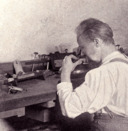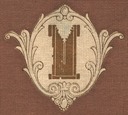All of the images here are in the public domain in the USA, with sources as indicated.
Often the originals are too large to present online. Click (or right-click to download) on each image for a larger (if not as large as possible) version.
The images which serve as links to other documents on this site are described on the "About the Images" pages for those linked documents.
This shows an unidentified employee of the American Type Founders Company at their Philadelphia branch ("Foundry C") cutting a patrix ( not a punch). It is from:
{MSJ 1896} One Hundred Years. Philadelphia, PA: MacKellar, Smiths & Jordan, 1896. ( An excerpt of the portions on matrix making, mold making and typecasting has been reprinted by CircuitousRoot .)
But this requires some unpacking.
American Type Founders was created in 1892 from the amalgamation of 23 foundries (about 2/3 of the type foundries in America at the time; at least 13 foundries did not join ATF). Three of the foundries which joined ATF were in Philadelphia: MacKellar, Smiths & Jordan, Collins & McLeester [aka M'Leester], and Pelouze & Co. (the "Philadelphia Type Foundry," which was distinct from the Richmond Type Foundry of Henry L. Pelouze). Of these, Pelouze disappeared as a distinct entity by 1893; the disposition of its materials is unknown. Collins & M'Leester received no mention as a distinct unit in the 1894 ATF annual report, but the 1895 report said that it had been consolidated into ATF's Baltimore operations (which were themselves in the process of consolidation from the original foundries). At some point the several consolidated ATF foundries were assigned letters (this was entirely internal to ATF). Philadelphia, which consisted primarily (or entirely) of the plant of the former MacKellar, Smiths and Jordan, was known as Foundry C.
So by 1896 MacKellar, Smiths and Jordan had not existed for four years. But it had been a large and proud foundry, it had largely (or possibly entirely) escaped consolidation with other ATF foundries, and it had good claim to having been the oldest continually operating foundry in America. It hadn't quite noticed that it was dead yet, and published One Hundred Years to celebrate its centenary. But setting aside the foundry's pride, unless they were recycling an older photograph (which is possible, but perhaps unlikely for a production as lavish as this book) this patrix cutter is working for ATF; there was no MSJ at this point in time.
For a detailed discussion of the history of the early foundry consolidations within American Type Founders, see the CircuitousRoot Notebook: American Type Founders - Early History through 1906 .
We know that he is cutting a patrix because he is seated at an engraver's bag rather than a punchcutter's bench pin. The other tools shown are, within the resolution of the photograph, identical to the tools of the punchcutter in steel.



